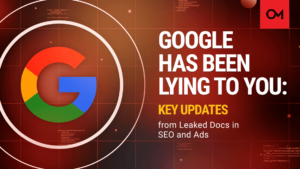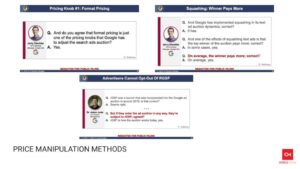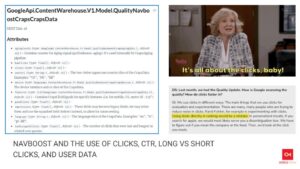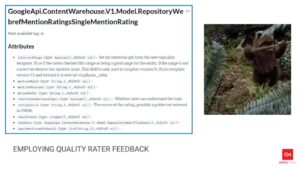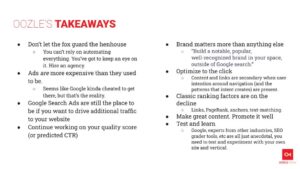Google Has Been Lying To You: Key Updates From Leaked Docs in SEO and Ads
Presented By: Patrik Connole, Director of Organic Marketing and David Steiner, Director of Paid Advertising
Oozle Media
Video not loading? Click here to watch.
Patrik Connole:
The good news about this update is that it’s actually pretty applicable across all of our marketing clients. We know we work a lot with post-secondary education and the whatnot, but Google is so ubiquitous and it can affect everyone. And so these updates are for all businesses. Even if you have a secondary business or anything else along those lines, or if you have friends and things, these will be some good updates just in general to hear about. This is stuff that Dave and I in particular, with our roles as directors here at Oozle Media, that we pay a lot of attention to because it really affects the day-to-day of everybody we work with here internally, and obviously affects what happens to our clients.
And so we just wanted to give some information about what has been happening with Google in particular of late. And so that’s kind of what stemmed this. There are a few timely things that we’re going to kind of go into. But if you have questions, please put them into the chat as we go along. We’ll maybe try to answer them right then and there if it makes sense, or we will have some Q&A at the end that anybody who has questions can go ahead and populate that.
David Steiner:
Yeah, so let’s go ahead and get started. I’m going to share this. So hopefully y’all can see our slide deck here. So yeah, basically what Patrik said, we’re going to go and do some introductions I guess really quick. So my name’s Dave. Patrik already alluded to this. I’m the director of the paid ads team. So we run everything on Google Ads, social media, whether that’s Facebook, TikTok, Snapchat, LinkedIn, etc. And then Microsoft ads as well. So that’s kind of my area of expertise.
Patrik Connole:
And then I’m on the opposite side of that, at least from a digital marketing perspective, where if it’s not paid directly to the platform, that’s where I’ve kind of been in charge of it. So SEO and content in particular, and then helping out with some of the websites that we develop. I offer some additional support there. And so today we have a couple of big things that have come out.
David Steiner:
So I guess Pat already said this, but the format will be, I’ll talk first about some things that have come to light on the Google Ads side and then we’ll turn it over to Pat. He’ll talk about some of the stuff that’s been leaked on the Google search organic side, and then we’ll come back for questions at the end. So if you have any questions along the way, like he said, put them in the chat, we’ll come back to those and we’ll talk about it there.
The Anti-Trust Case
But yeah, so to start off, I want to talk about the antitrust case that’s been going on with Google. I’m not going to get into all of the details, but the Department of Justice has brought an antitrust case to Google. They’d actually brought two. One of them was accusing Google of monopolizing its ad tech. I’m not going to really get into the subject of whether or not they have monopolized it or what the ramifications might be depending on the result of the trial. But there were some interesting insights, some admissions by Google execs that came to light in this trial, and they were referenced in some of the closing arguments. So that’s what we’re going to go through today. The slides of the closing arguments were made public.
I think the closing arguments were held on May 3rd and 4th. And then sometime shortly after that, they were made public and they had some pretty interesting admissions, I guess. So that’s what we’re going to look at today.
The first thing is very fascinating. So basically these quotes from the trial are admissions from Google execs that they have pricing knobs or ways to tune or manipulate the auction on Google Ads.
How Google Manipulates Ad Campaigns
So in theory, Google Ads is an auction-based market, right? Anybody who wants to put a search ad on Google makes a bid. And when a search happens, in milliseconds, this auction happens and it ranks whoever has the highest bid and a few other things to determine what rank order those top three ads are shown. But in this case, we are hearing from Google that they have a mechanism in which they can weight those bids a little bit differently and tune that auction to increase prices. As you can see in the slide, it says, “Tunings can impact pricing, correct?” And he responds, “Yes, they can.”
So Google has more or less been inflating the prices for search ads over the last few years, and we’re going to get into three of the ways that they do that.
Now, I’m not going to go too in-depth on the details of how they work, but basically they admitted to three different pricing tuning knobs:
- Format Pricing
- Squashing
- and this thing called Randomized GSP
They’re all kind of technical, so I’m not going to worry about them. I’m not sure I really understand them. But they all function in essentially the same way. They all arbitrarily or artificially increase the bid of the second place bidder. Google has always claimed that the winner of the auction will pay no more than one penny above what the second place bidder pays. And they’ll never pay more than their maximum bid. But if they have a way of arbitrarily increasing the bid of the second place bidder, that means that the winner is now paying a higher price to win that auction.
So like I said, there are these three different ways to do it. You can see in these quotes that they are admitting to having done this. Everybody is sort of subject to this. This has been going on for a few years. I think in 2019 is maybe when it sort of picked up, you can see in this slide about the RGSP. But this isn’t the only thing that they’re doing. They’re changing the platform in other ways that are maybe a little bit more blatant or less secretive, at least.
Match Types
If you guys are familiar with match types on Google, they’re expanding those match types. So historically there’s been exact match keywords, which means that the search query has to match that exactly, like it sounds. Phrase match, which means that your search keyword has to be found within the search query’s phrase. Or broad match, which just sort of is based more on intent or intention. If it’s related to that term, then it will pick up and you’ll show up for that search query. Because they’re broadening all of those, now exact match is kind of a bit more broad. Now phrase match is more intention based. And now broad match is getting really a lot more traffic than it used to. They’re kind of thickening the market, right? They’re introducing more bidders into the same search query than there used to be. So making that auction thicker, putting more advertisers into that bid has the effect of making it a little bit more expensive for the winner.
Decreasing Visibility
The other thing that they’re doing on the advertiser side of the platform is decreasing a lot of the visibility. So they’re taking away some of the reports and insights that we used to get and making it a little bit harder for advertisers to opt out of certain queries. So both of those have kind of a similar effect. They’re making it harder to be more specific with your search queries or with your bids and what you might show up for. So again, all of this, those last two things I mentioned plus these three kind of tuning knobs, pricing tuning knobs that they have, have the effect of increasing our overall spend on the platform without necessarily increasing the results that we get. We’re not getting more leads necessarily, or sales, but it is becoming more expensive.
Patrik Connole:
So Dave, would you say that it’s true that by taking all these adjustments and showing it to a more general audience of things, that less qualified visitors are seeing more of your ads?
David Steiner:
Absolutely. Yep. That is definitely the case.
Now, if you’ve noticed that over the last few years you’ve started paying more than you did for the same number of leads, you’re not crazy. And it doesn’t necessarily mean you’re doing a bad job or that your agency is doing a bad job. That’s what really everyone is seeing across the board. And again, it’s because of these things that they’ve been doing on their platform. That being said, I think that the fact is still true, that if you want to drive more traffic to your website and you want to get more leads, a good way to do it is still by using Google search, paid Google Ads. It still dominates the market today.
You can see this is the graph that I’m showing here. The second place competitor is Bing, and they hold a small fraction of the market share. This was in 2020, I think that’s probably not changed a lot in the last couple of years.
So yes, they still dominate the market today, and you can still run an effective search strategy on ads, and you can still make money out of it. You can still be profitable even if it does cost more than it used to.
The main takeaway in my opinion, and we’ll come back to this in a little bit, is that you can’t just trust Google to automate everything for you in your best interest. You can’t take all the recommendations at face value. You can’t trust the fox to guard the proverbial hen house, so to speak. You need to be watching what they’re doing and working on your own ways to keep things as relevant as possible for the audience that you’re going for. And like I said, make sure things aren’t left entirely automated.
So that’s it from the antitrust case. Those are the main points I wanted to share. Like I said, if you have any questions or anything else you want to ask about, feel free to put it in the chat or write it down. We’ll come back to questions in just a minute. But I’m going to turn it over to Pat to talk about the leaked docs.
Patrik Connole:
Yeah, and I’m sure more will continue to come out with the antitrust case, and we’ll continue to try to give some updates as we go once we continue to see more information. So with the leaked docs, I’m sure not as many of you are quite as aware of this one. It hasn’t made as much publicity as the DOJ case.
But very recently, within the last couple of weeks, Google actually released accidentally, admittedly, 14,000 different documents that outlined a lot of their Google algorithm processes, which is unheard of in the SEO space to have any sort of access to Google secret sauce within their organic algorithm. And so there’s a lot to dissect. And a lot of people who are smarter than I am are on the job looking at that. And I just kind of take that information, synthesize it and say, what does this actually mean for our clients or for people that we work with?
Leaked Docs About Google’s Algorithm Process
If we look at this, here’s an example of what it looks like. There’s a lot of data here. And you can see, it’s very developer style heavy, if you’re familiar with GitHub or something like that.
So, what we’re trying to do overall is look at what do these words mean and what do these terms mean? And how does it affect what Google has said in the past?
Google Cares About Clicks
Previously, Google has said something like, “Using clicks directly in rankings would be a mistake.” And they’ve come out and exactly said that. However, in here you can very clearly see, kind of towards the end over here, it’s like last longest clicks, good clicks, clicks, bad clicks. Seems pretty damning and sort of evidence there that they are actually using clicks and post post-click behavior, so after somebody clicks into your website, what else do they do on your website, where do they go, what do they interact with, as part of their ranking algorithm.
Google Uses Chrome Data in Rankings
There’s another thing that they put in there is called NavBoost, which has been kind of interpreted ads and has been verified by some people who used to work at Google and have kind of been able to say some things to officially confirm it, that the way people navigate your website has an impact on what happens with your algorithm rankings. As well as user data.
They’ve explicitly stated several times that they don’t use your Chrome data. And that’s actually not true at all. They use your Chrome browser, so anybody who ever uses Chrome, they track everything that you do on there. And then they use the number of clicks within that page to determine the popular and important URLs in a site.
So you can see how things that they’ve said explicitly, right? Here’s an SEO professional that was asking Google, the representative, his name is John Mueller, back in the day. He says, “I don’t think we used anything from Google Chrome for ranking. So the only thing that happens with Chrome is the page experience report or Chrome user experience report data. It’s kind of data aggregated, but it doesn’t go towards algorithm.” It’s basically what he was saying. And within that, there’s an actual reference here for Chrome in total, site level Chrome views or other sorts of things that kind of indicate that Google does use Chrome data to manipulate the rankings there.
There’s been a lot of SEOs, myself included, that have suspected this for many years, but we could never get it officially verified. Kind of a similar thing to what Dave was saying earlier where it’s like you can’t really trust Google to actually give you the information. You need to see it with your real eyes.
Here’s another one. They have something called EWOQ, not that Ewok that’s dancing on the screen there. But it’s basically a way that they use quality raters to be directly involved with Google search system. So not only does Google have a whole bunch of math and algorithms and data and all that together, they actually use real people, too, to go through Google search system. And what they have said previously is that they use it as a training set for experiments that they run so that it can then get implemented later. However, it looks like they actually directly employ the quality rater feedback directly onto actual algorithms. Again, just kind of calling Google’s bluff here.
Domain Authority
And then another thing that’s on here, and I have said this, is that Google doesn’t use site authority. That’s just a term that SEO people have made up, which is true. Or domain authority is another thing. Which is true, we made up that term, domain authority because we didn’t know what else to call this kind of like how Google would tier out websites.
If you’re relatively better than everybody else, then you’re kind of in a tier of this domain authority. And they’ve literally said, “We don’t really have overall domain authority.” They have something called site authority that they may have obfuscated by saying, “We don’t have domain authority,” but they have site authority. Same biz. We know exactly what you’re talking about. It’s something that’s used within the quality ranking system. And they claim, “We have it but we don’t use it, or you don’t understand what it means.” And it says, “I mean, yes, we may not understand everything that goes into it, but you very clearly have something here. Stop trying to lie around it.”
Response to Leaked Docs from Google
Now, Google did come out with a response to the leaked documents, which confirms a little bit more the validity thereof of those documents. And they basically said, “We would caution against making inaccurate assumptions about how our search works and how the algorithm works based on out of context, outdated,” which I would contest that it’s not necessarily outdated, “or incomplete information.” And that they’ve shared a lot of information about how it works. And that is true. They have shared a lot of information about how it works, and we don’t have the full context about everything regarding the search engine, but we have 14,000 more factors that we didn’t have previously.
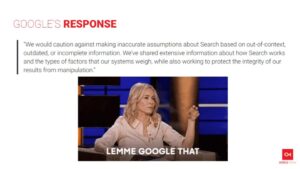
We don’t have any sort of scoring functions within the data set that was released here. So we don’t know, say one thing is, this is weighted to be 40% of the algorithm, which, something would never be that high. But say 4% of the algorithm goes towards this thing, and 2% goes towards this thing, and 0.0004% goes to that thing. We don’t have that sort of scoring metric, and nor do I expect Google to ever release that sort of thing. I think that it does appear to be relatively current, as of March 2024 to do that. And then yeah, kind of like what Parker says here, caution against incorrect assumptions, right? Yes, correct. We don’t want to have inaccurate assumptions for sure. But what about the assumptions that we have had that are correct, and that we know is going on, and that Google just won’t admit to or provide any sort of validation against?
Main Takeaways
So we’re going to bring Dave back over here. We have a couple of takeaways on both sides here. There’s a lot of information here to digest, and what does it all mean? So I’ll kind of go first here and then you can kind of flash back to where you’re at. But from a lot of experts that I’ve read, Rand Fishkin who has been helping break this news and has been an inspiration for SEO analysts for a long time, has kind of listed this out in a really nice format. So I’m stealing this from him a little bit, but kind of putting it into our own terms for our clients.
Your brand is what matters more than anything else. And he says, “Build a notable, popular, well-recognized brand in your space.” Now you can interpret your space to mean a lot of different things. For me, it means, if you have a brick and mortar, it means in the area that people would reasonably come visit you, to your brick and mortar. They would be willing to drive to you for payment of whatever services you may offer. If you’re more widespread than that, you’re able to do an e-commerce platform or you’re able to do anything of that sort of space. Your space is actually a lot bigger, right? It also encompasses that.
Your Digital Marketing Presence Matters
Additionally, your space matters in digital marketing because it’s your social media platforms, your email lists, anything that your presence, your brand could be seen, billboards, TV ads, whatever else. That’s your space. That’s where you can build. It’s where your audience lives, where people can find you. And that can live outside of Google search. We have noticed, over many years, that if you have a more recognizable brand, it’s way easier to do things, for you to make you rank more magically. It just happens. It’s not magic, it’s just the algorithm weighting it more.
Optimize to a Click
This next thing that we talk about is you need to optimize to a click. The click is the holy grail of an action somebody can take on your site, whether that’s for paid ads or for SEO. If somebody clicks on it, we know that they were most likely interested. And they do multiple clicks after clicking into something, and they navigate around, and we can see that pattern, that we can see that that works.
Classic Ranking Factors
There’s also a lot of classic ranking factors that are undeclared. And Google has openly said this in a lot of other spaces too. Like for instance, they said links are no longer a top five ranking factor. It may not even be a top 10 ranking factor anymore. Things like page rank or your anchor text or having exact text within your title tag or your meta description or your page on your site does not have as much weight as it used to. But rather, it’s more experiential.
How are you serving the people that come to your site? And so what we say a lot of is, make great content and then promote it really well. That’s why Dave and I work together a lot, is that my team, we try to make the really great content. We try to find out what people are interested in and make that great content. And then we shift it over to the paid area where people can then promote it and you can get it right in front of the right eyeballs.
Test & Learn from Results
And then the last thing is, test and learn. Google, experts from other industries, SEO grader tools, they’re all just anecdotal, they all have a piece of the puzzle. You need to be able to test and experiment with your own site that is in a different locale, in a different audience, in a different brand level than even your next door neighbor who is your competitor, or somebody who’s clear across the other side of the country.
You need to be able to do that within your own space, your own site, your own vertical, wherever you’re at. And when you work with a company like Oozle who has a lot of experience within a certain vertical and a lot of experience with digital marketing in general, we can kind of take some of the broader level assumptions, apply those assumptions into that, and then test it against how that works with your site specifically, which is what we love doing.
David Steiner:
As for the Google Ads side of things, I sort of mentioned some of these takeaways already.
Inflation on Paid Ads Platform
Basically, like I said, don’t let the fox guard the hen house. Google, they want to be the keeper of your did strategies and things like that, but you can’t necessarily rely on everything that they tell you or they recommend in your ad account. You’ve got to keep an eye on things. A lot of times we know that business owners don’t have time to do that, so the alternative would be to hire an agency, somebody who can keep an eye on things like that for you.
Ads are more expensive than they used to be. Consider it inflation or however, you want to do it. Google sort of maybe cheated or maybe manipulated the system to get that way, but that’s the reality of the situation. So investing the same amount today that you did a few years ago is not going to get you the same results.
As mentioned, Google Ads are still the place to be if you want to drive additional traffic to your site. It is still a valuable and a beneficial tool if you can use it. As I mentioned, not every one is going to have time to keep up on this stuff. I got a lot of my resources from a source called Search Engine Land. So if you want to check them out, they’ve got a lot of great stuff about both organic and paid Google topics to look at.
But in addition to that, if you can keep working on your quality score, your expected or sorry, predicted click-through rate. I didn’t really get into it a lot, but one of the pricing knobs that they have has to do with your quality score and predicted click-through rate. So that’s one of the ways to sort of mitigate the impact of the increasing prices.
Patrik Connole:
And quality score’s just basically kind of like how relevant your website or your ad is to the actual person searching, right?
David Steiner:
Yeah, it’s predicted click-through rate. How many clicks Google thinks your ad is going to get.
Patrik Connole:
And then here’s one big question that we kind of still have that’s especially about Chrome data, because this is kind of a bit of a new revelation. We haven’t seen a lot of studies into this on our end. But if Chrome click stream data is being used for rankings, does that mean that paid clicks could boost organic rankings? As of right now, we don’t know for sure.
We know there’s a noticeable positive effect on both paid ads and organic search when they’re used together. And whether that’s just like a tide raises all ships, your brand is pushing up or anything along those lines altogether, you just happen to have more stuff happening for you, or it’s actually part of the algorithm. The result’s the same at the end of the day. For us, doing good marketing involves both things. It doesn’t have to be just one or the other. Synchronization is really important here.
David Steiner:
I just got a reminder. Some of these things are going to be a little bit more visible, if you are an Oozle client, we’re making updates to our reports that you’ll see coming soon. Those reports are going to give a little bit greater visibility into click-through rates, both organic and paid. So keep an eye on that. That should help navigate some of this stuff. There are other updates coming into those reports as well, so if you’re an OOzle client, keep your eyes peeled.
Patrik Connole:
We’re very excited. I’ve seen the preview of these reports, and they’re awesome. So good work to Parker and his team. Very excited.
David Steiner:
So on that note, are there any other questions that anybody has? There wasn’t anything else that made it into the chat, but we left a little time here at the end. And if anybody has any additional questions for us, we’ll give you just a moment or two to plug anything in here to the chat if you’ve got it.
Patrik Connole:
Yeah, Michael, that’s a great question. So at the end of the day, there’s a lot happening.
David Steiner:
The question is, what will it mean to us financially?
Patrik Connole:
What will it mean to us? It means that everything is getting more expensive.
David Steiner:
On the Google Ads side, your investment will have to increase in order to get the same results that you used to get.
Patrik Connole:
And there’s not a lot of levers that we can pull per se on our end. We will do our best to increase your quality score, to increase the click-through rates, to navigate the clicks. I would say another thing is if you have an old website that has not a really good user experience, I would say investing in a website that has a very good user experience will help you out a lot more than it used to.
David Steiner:
Sorry, lights just went out here. Both for the organic side, but for the paid side as well. Having having a site that has a good conversion rate will help you increase the results that you get with the same amount of investment. So even though maybe the cost per click is going up, if you can on the other side of that equation increase the conversion rate, then you’re getting more out of the same amount of money. I, for a while, noticing the trend that everything is getting more expensive on Google, sort of just considered it inflation. Nothing is immune to inflation. So if that’s a maybe more comfortable way you want to think about it. Prices are going up everywhere, Google is not excluded from that. Whether or not they did that on purpose, I won’t say. Well, I guess I did.
Patrik Connole:
I think Dave’s right here. Your best bet at making the best optimal approach for you is to have a really good pipeline throughout the entire process. It’s not just enough to have a good Google Ads person on your side. It’s not enough to just have a really good SEO person on your side. It’s not enough to just have a good website. But if you have all of them, then your overall costs will be more manageable even though you may be paying more money to make more money sort of space.
David Steiner:
Another interesting thing that I was thinking about when it comes to the financial side of things. I’ve been seeing reports, we’ve been talking about it a lot here at Oozle, that on average the marketing budget that a company has is going down. I think it used to be something like 11% a few years ago. And then during the Covid era it kind of went down to six something percent. And I think it’s bounced back a little bit, but it’s still hovering around seven and a half percent maybe. So marketing budgets today across the board from businesses are down from what it used to be. So maybe just take a look. I can’t speak to everybody’s business, but maybe take a look at what your business is investing in marketing and see how it stacks up to other businesses, or maybe over time how that’s changed.
Patrik Connole:
Other questions?
David Steiner:
Yeah. Anything else? Okay, if there are no other questions, I guess we’ll wrap it up. Oh, yeah.
Patrik Connole:
Yeah, I mean this is our wrap-up. So here’s kind of three ways that we can do this. There’s three things. So if you’re a current client, which a lot of you are, go back, review The Beauty Summit. I think it would be the number one big thing that you can do there. The On-Demand Library is now live, and we have a lot of really good information in there that talks a lot about some of the financials, some about the website, about what you can do from an SEO standpoint or paid ad standpoint. There’s a lot of really good information there. We also have a Beauty School Marketing Guide. We’ll send this presentation out and you guys can click on that link that’s listed right in there, and it’ll take you right to it. If not, you can always ask your account manager.
Or if you want to be a new client, you can always ask whoever’s working with you on the sales side of things. If you are not a current client, we do something called an X-ray, where we go through and have our team go look at your business and provide kind of a recommended marketing plan to increase where you’re at. And if you’re a current client, we do a similar thing. We just don’t call it an X-ray. It’s a general kind of analysis of strategy that you’ll do on a regular basis with your account manager, because we know that it’s always evolving, right? No one size fits all situations. And we want to make the best of that. And our account managers are well-trained in understanding how to best use your budget to its max limit.
David Steiner:
Yep. The X-rays in particular could be very helpful if you’re not a new as a client. So big shout out to those if you want to do one.
Patrik Connole:
The hope is that even if you don’t become our client, that you get actionable takeaways that you can apply whether you’re with another company or with us, or if you’re just going to take it in-house.
David Steiner:
Right. So yeah, that’s it from us. Thank you very much for your attention and participation. Appreciate it.
Patrik Connole:
Absolutely. And if you need anything else, you can always, again, talk to your account manager, go fill out a form on the site. Whatever you need, we just want to give good information and be helpful. So we’re going to wrap it up there and we will send this out so you can kind of rehearse it and see it again. But thank you everyone for coming.
David Steiner:
Yeah, thanks. Have a great rest of your day.

